#Whitney Biennial 2019
Text
Clio Art Fair Reviews - A call to fame named Clio Art Fair
In a art world characterized by a proliferation of art fairs, Clio Art Fair has emerged to gain a spot in the pantheon of satellite Armory Show realities, and is officially doubled up becoming a Frieze Satellite since 2017.
Differentiating itself for the focus on independent artists, since 2014 Clio Art fair has been highlighting the work of independent artists without New York gallery representation. The raison d’être of the fair is to highlight and promote their work, while creating a platform for discovery and innovation.
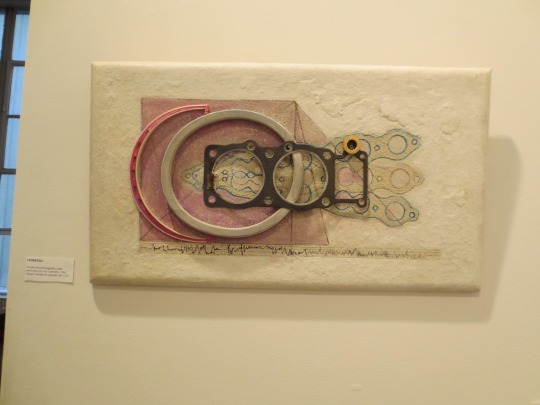
The name is inspired by CLIO who in Greek mythology, is the muse of History. When Clio sings your name while playing her harp, your name is admitted to the mental olympus of human history. Reflecting the ambition of many artists seeking recognition, Clio Art Fair created an alternative to the nepotism of the art world, and looks to highlight that which lives outside its domains.
Elegantly designed without booths and without commercial compartmentalization of spaces, the fair feels like a large curated group show where intergenerational artists work across media. There are no booths, no tables, no chairs in the exhibition space, instead, a team of art dealers graze the grounds prepared to trade on behalf of the artists.
Every independent artist without exclusive representation in New York City, can submit work from all over the world, and if selected, can be part of a curated international group show.
The fair becomes a window shedding light into current artistic practices that live outside the concerns of the art world taking risks and providing artists with visibility. Through a series of related events and programs, including a press preview, and multiple VIP openings, they have the opportunity to meet art dealers, curators, art critics, art lovers, while sipping Italian champagne. A plus of the fair is free logistic assistance for the non New York based artists: free transportation and free storage in NYC few weeks before and after the Art Fair.
Most notable, is how Clio combines both emerging, middle career, and iconic independent artists including, Vito Acconci, Nina Berman (Whitney Biennial 2010), and Thirza Cuthand (Whitney Biennial 2019) in the same space, providing a show of substance where the quality of the work is prioritized over length of artists CVs.
The fair born in chelsea, will continue to run twice a year in the heart of Chelsea, the epicenter of the art world, nurturing artists while singing the musings of their eclectic practices.
Our journey dedicated to the reviews of previous editions of the Clio Clio Art Fair Reviews today to its first edition in 2014.
"The Clio Art Fair 2014 stood out for a mix composed of historical artists, those in the process of establishing themselves, or completely new and unknown to the public, as well as to the art professionals in the Big Apple. Among the 33 artists on display, there were numerous works by established artists, including some drawings by Vito Acconci, and a photographic series dedicated to the Bronx by Mel Rosenthal. No galleries were directly present at the event, which originated from the initiative of curator Alessandro Berni. "It's difficult to surprise a saturated city
like New York," says Berni. "I wanted to try with this initiative based on the denial of the gallery's role as an intermediary between the artist and the collector."
A review of all the Clio Art Fair Reviews artists included in the 2014 edition are visible here.
#Clio Art Fair Reviews#fame named Clio Art Fair#since 2014 Clio Art fair#New York#Clio Art Fair Artists Reviews#Whitney Biennial 2019#Berni
1 note
·
View note
Text

Calvin Marcus’ Tall Snowman, 2019, (Watercolor and vinyl paint on linen), was one of several of his large paintings included in Whitney Museum’s 2019 Biennial.
He and fellow Los Angeles artist Laura Owens will be in an exhibition together at Gaga gallery’s Guadalajara, Mexico location, opening 2/2/24.
#Calvin Marcus#2019 Whitney Biennial#Art#Art Shows#Painting#Winter Painting#FBF#Gaga#Gaga Gallery#Guadalajara Mexico#Laura Owens#Los Angeles Artist#Mexico Art Shows#New York Art Shows#NYC Art Shows#Snow#Snowman#Whitney Biennial
1 note
·
View note
Text
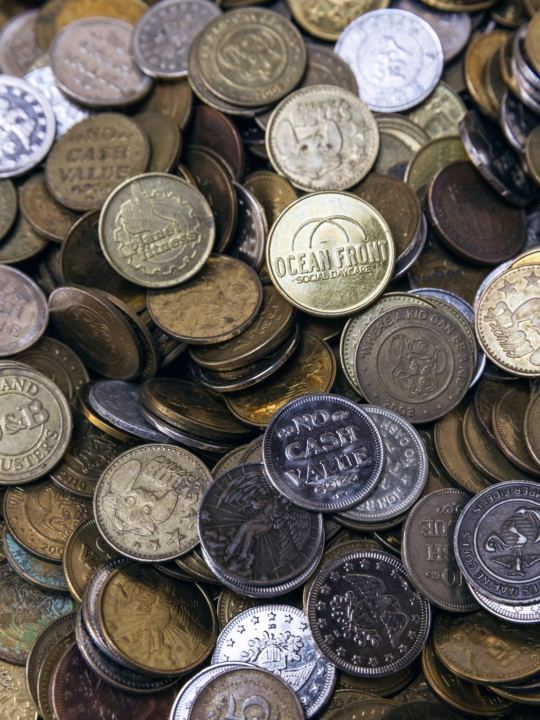
The project [that premiered at the Whitney Biennial 2022: Quiet as it’s Kept] has been a long-term investigation, a very physical, haptic process of sifting through 64,000 coins that I bought at an MTA transit auction. The lot of coins was referred to by the agency as ‘slugs,’ which are counterfeit currencies that are used to trick coin-operated devices. However this surplus I received contained a variety of coin-like objects ranging from arcade and casino tokens, to restroom and car wash tokens, as well as religious keepsakes, pendants and batteries. All these items had been used by NYC commuters as bus fare payment from 2017 to 2019. I sat with this collection for two years after purchasing it until I came to understand the random patterns that formed the internal logic. Each coin traces a possible history; it could be a remnant from a major experience or a forgotten occurrence. I’ve identified five categories: Faith, Place, Chance, Imitation, and Blank. Every coin can fit into one of these categories. I am interested in the tokens’ ripple effect, speculating as to the amount of time an individual held onto the ‘slug’ and the multiple spaces the person passed through with this object.
26 notes
·
View notes
Text
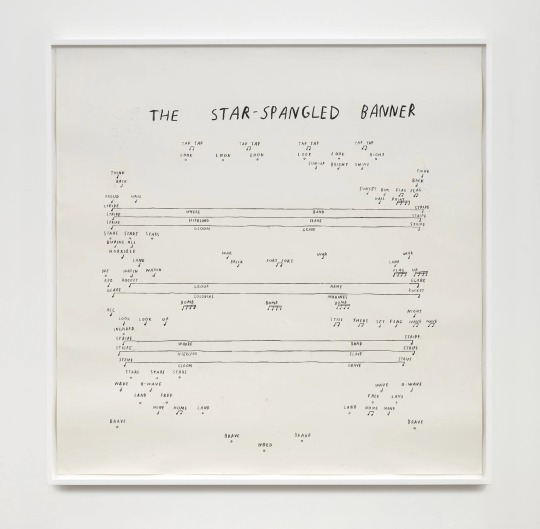
Christine Sun Kim, The Star-Spangled Banner (Third Verse), 2020, charcoal on paper, overall: 58 1⁄4 × 58 1⁄4 in. (148 × 148 cm) frame: 60 3⁄4 × 60 3⁄4 in. (154.3 × 154.3 cm), Smithsonian American Art Museum, Museum purchase and purchase through the Asian Pacific American Initiatives Pool, administered by the Smithsonian Asian Pacific American Center and through the Julia D. Strong Endowment, 2021.31.1, © 2020, Christine Sun Kim. Courtesy of the artist and François Ghebaly, Los Angeles
Christine Sun Kim (born 1980) is an American sound artist based in Berlin. Working predominantly in drawing, performance, and video, Kim's practice considers how sound operates in society. Musical notation, written language, American Sign Language (ASL), and the use of the body are all recurring elements in her work. Her work has been exhibited in major cultural institutions internationally, including in the Museum of Modern Art's first exhibition about sound in 2013 and the Whitney Biennial in 2019. She was named a TED Fellow in both 2013 and 2015, a Director's Fellow at MIT Media Lab in 2015, and a Ford Foundation Disability Futures Fellow in 2020. Via Wikipedia
16 notes
·
View notes
Text

THE FRIDAY PIC is Mavis Pusey's Within Manhattan, from 1977, now in the 2024 Whitney Biennial.
The almost-sort-of-maybe-not abstractions by Pusey (1928-2019) really feel as though they had something to say about art, and the world, as both existed at the moment she was making this work.
I can't say as much about pretty much anything else in the Biennial, except Isaac Julien's brilliant piece on Albert Barnes and Alain Locke. But then, I'm not impartial on that front — I'm just now on my last days of writing Barnes's biography, and Locke of course figures in it.
Image © Estate of Mavis Pusey. Photograph by Elon Schoenholz. Courtesy of the Whitney Museum of American Art.
9 notes
·
View notes
Text
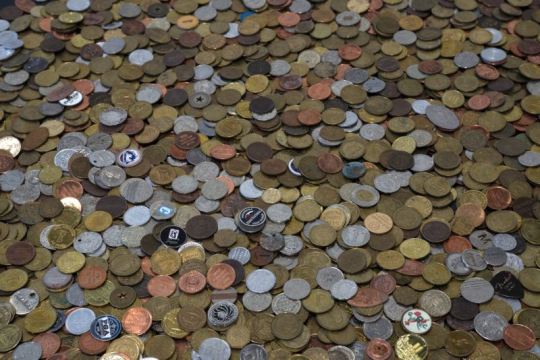
Rose Salane – The project [that premiered at the Whitney Biennial 2022: Quiet as it’s Kept] has been a long-term investigation, a very physical, haptic process of sifting through 64,000 coins that I bought at an MTA transit auction. The lot of coins was referred to by the agency as ‘slugs,’ which are counterfeit currencies that are used to trick coin-operated devices. However this surplus I received contained a variety of coin-like objects ranging from arcade and casino tokens, to restroom and car wash tokens, as well as religious keepsakes, pendants and batteries. All these items had been used by NYC commuters as bus fare payment from 2017 to 2019. I sat with this collection for two years after purchasing it until I came to understand the random patterns that formed the internal logic. Each coin traces a possible history; it could be a remnant from a major experience or a forgotten occurrence. I’ve identified five categories: Faith, Place, Chance, Imitation, and Blank. Every coin can fit into one of these categories. I am interested in the tokens’ ripple effect, speculating as to the amount of time an individual held onto the ‘slug’ and the multiple spaces the person passed through with this object.
....
3 notes
·
View notes
Text

Philip Taaffe (American, b. 1955)
Anthology (Blue), 2009
Mixed media on canvas, 39" x 28¼"

Philip Taaffe (American, b. 1955)
Imaginary Garden with Seed Clusters, 2013
Mixed media on canvas, 97⅞" x 61⅞"

Philip Taaffe (American, b. 1955)
Double Acrosticum (Deep Magenta), 2014
Mixed media on canvas, 76¼" x 55⅛"

Philip Taaffe (American, b. 1955)
Tesserae II, 1990-2015
Mixed media on canvas, 40" x 28"

Philip Taaffe (American, b. 1955)
Blue Manuscript, 2016-2018
Mixed media on canvas, 80¼" x 60"

Philip Taaffe (American, b. 1955)
Holothurian Passages, 2019
Mixed media on canvas, 79¾" x 114"

Philip Taaffe (American, b. 1955)
Totemic Figures, 2022
Mixed media on canvas, 88¾" x 52⅛"

Philip Taaffe (American, b. 1955)
Prismatic Figure, 2022
Mixed media on panel, 62¾" x 22½"

Philip Taaffe (American, b. 1955)
Flowering Leaves II, 2023
Mixed media on canvas, 60½" x 54⅞"

Philip Taaffe (American, b. 1955)
Illumination, 2023
Mixed media on canvas, 92¾" x 66½"
Artwork by Philip Taaffe - Gallery 2
See Gallery 1 (containing ten paintings) of this two-part series at next post, above.
A selection of paintings by Philip Taaffe
All artworks ©️ Philip Taaffe
Philip Taaffe artist biography
Philip Taaffe was born in Elizabeth, New Jersey in 1955 and studied at the Cooper Union in New York. His first solo exhibition was in New York in 1982.
He has traveled widely in the Middle East, India, South America and Morocco, where he collaborated with Mohammed Mrabet on the book Chocolate Creams and Dollars, translated by Paul Bowles (Inanout Press, New York: 1993).
Taaffe lived and worked in Naples from 1988-91. He has been included in numerous museum exhibitions, including the Carnegie International, two Sydney Biennials and three Whitney Biennials.
In 1990 his work was the subject of an extensive critical study in Parkett no. 26 (Zurich & New York). His work is in numerous public collections, including the Museum of Modern Art, New York; the Philadelphia Museum of Art; the Whitney Museum of American Art; and the Reina Sofia, Madrid.
In the year 2000, the IVAM museum in Valencia organized a retrospective survey of his work, with contributions by Enrique Juncosa, Robert Rosenblum and Robert Creeley.
In 2001 an extensive survey of his work was presented by the Galleria Civica of Trento, Italy (with texts by Vittoria Coen and Francesco Pellizzi).
In 2004 the Galleria d’Arte Moderna in San Marino (Italy) presented a survey of paintings and drawings based on the artist’s explorations with floating pigments and the paper marbling process, accompanied by the Skira publication, Carte Annuvolate (Cloud Papers) with esssays by Peter Lamborn Wilson and John Yau.
In 2008 the Kunstmuseum Wolfsburg organized a retrospective survey, The Life of Forms in Art: Paintings 1980-2008, with a publication by Hatje Cantz, featuring contributions by Markus Brüderlin, Holger Broeker, Kay Heymer and Brooks Adams. Philip Taaffe presently works and lives in New York City, and West Cornwall, Connecticut.
•
•
You can find a catalogue of Philip Taaffe’s artworks, exhibitions, publications, reference texts and contact details at his website, here:
•
•
Philip Taaffe reference at Wikipedia:
•
0 notes
Text
Exhibits to See: New York City
Don't Forget to Call Your Mother
Through September 15, 2024
https://www.metmuseum.org/exhibitions/don-t-forget-to-call-your-mother
Seen Together: Acquisitions in Photography
January 26 through May 26, 2024
https://www.themorgan.org/exhibitions/seen-together
ICP at 50: From the Collection, 1860–2019
Jan 24, 2024 – May 06, 2024
https://www.icp.org/exhibitions/icp-at-50-from-the-collection-1860%E2%80%932019
KLIMT LANDSCAPES
February 15-May 6, 2024
https://neuegalerie.org/klimtlandscapes
The Harlem Renaissance and Transatlantic Modernism
February 25–July 28, 2024
https://www.metmuseum.org/exhibitions/the-harlem-renaissance-and-transatlantic-modernism
Whitney Biennial 2024: Even Better Than the Real Thing
Mar 20, 2024–
https://whitney.org/exhibitions/2024-biennial
Francesc Tosquelles: Avant-Garde Psychiatry and the Birth of Art Brut
April 12, 2024–August 18, 2024
https://folkartmuseum.org/exhibitions/tosquelles/
Somewhere to Roost
April 12, 2024–May 25, 2025
https://folkartmuseum.org/exhibitions/somewhere-to-roost/
Jenny Holzer: Light Line
MAY 17–SEPTEMBER 29, 2024
https://www.guggenheim.org/exhibition/jenny-holzer
Vivian Maier Unseen
MAY 31ST – SEPTEMBER 2024
https://www.fotografiska.com/nyc/exhibitions/vivian-maier/
Crafting the Ballets Russes: The Robert Owen Lehman Collection
June 28 through September 22, 2024
https://www.themorgan.org/exhibitions/ballets-russes
Harmony and Dissonance: Orphism in Paris, 1910–1930
OPENS NOVEMBER 8, 2024
https://www.guggenheim.org/exhibition/harmony-and-dissonance-orphism-in-paris-1910-1930
0 notes
Text
Dana Schutz: Societal ambivalence and how identity can be appropriated.
Born in Michigan in 1976, Dana Schutz is a divisive artist who is known for her surrealist borderline gore paintings. She received her BFA from the Cleveland institute of Art and her MFA from Colombia University, New York. She currently lives and works in Brooklyn, New York.

Fig 1.
Often described as “ambivalent” (Schutz, D. and Levine, C.S. 2011, p.10), her work focuses on the social and political status of America. Her works can be seen as critical, making a mockery of capitalism and the American empire, yet within each criticism there are glimpses of positivity with her use of “riotous colour” (Earnest, J. 2012) and the fact her figures continue with life despite their circumstances. An example of this is with Civil Planning (Fig 1.), which depicts 2 people calmly discussing in the middle of an apocalyptic land. As said by Levine.C (2011), The paintings highlight how ridiculous it is to plan for the future in such a broken and uncertain society, although it also highlights how younger generations are often more hopeful for the future.
I chose her work because I personally resonated with her political work; Like many people, my stance in society/politics is a part of my identity. My identity itself is politicised in the current climate. I connected with the way she used horrific imagery to explore these facets of identity yet paired them with bright colours that make such imagery even more sickly. Her work reminded me of Francis Bacon, an artist I’m already inspired by and connect with the work of.

Fig 2.
In her exploration of society and politics, however, she became a controversial figure due to her painting Open Casket (Fig 2.) As explained By Drew, K (2022) the painting depicts Emmet Till, a 14-year-old boy who was kidnapped and brutally murdered in 1955. His mother had sent photos of his open casket to multiple Black-press outlets to let the people see what she’d seen. The paintings inclusion in the 2017 Whitney Biennial in New York sparked backlash from the public and lead to protests. The consensus was that “It is not acceptable for a white person to transmute Black suffering into profit and fun, though the practice has been normalized for a long time.” (Speidel.K. 2017). People called for the painting’s removal and even for its destruction, as they felt it was wrong for a white woman like Schutz to use Black Suffering in her artwork. She later tried to defend herself, stating that she didn’t see it from a racial perspective but instead from the stance of a mother and a son. Whilst it explains her motive, it just highlights further how detached she is from this subject; she is allowed to be moved by such a subject, but trying to equate her white motherhood to this is ignorant as she will never have the same fears of her child being racially targeted as a black mother would. As said by Speidel, K (2017), “To equate white motherhood, black motherhood and the fear that runs through each of them is violent and nothing else.”
On the other hand, it raises an interesting question of censoring in the art industry; what can be done by who? What should be done with work that is controversial? Whilst I don’t agree with her choosing to paint this, I believe the discussion is created is an important one. Art has always been controversial; it’s always been a way to push boundaries and push for change yet censoring that would destroy the political power that art can have. As said in the article by Tomkins. C (2019), “Hannah Black (One of the most vocal protesters) and company are placing themselves on the wrong side of history, together with . . . religious fundamentalists who ban artworks in the name of their god,”.
This whole controversy with Schutz can be seen as someone appropriating or miscrediting identity; she chose to paint a figure that is sacred to the Black-American community and assign her own identity to the experience, without seeing how insensitive that could be to the primary community that still feel the racial injustices that lead to Till’s murder to this day. It highlights how we naturally try to find ourselves in situations and link them to our own identity and experiences, but how that can do more harm than good in some cases. I believe this situation became so controversial due to the political unrest at the time in America; it was exhibited within the same year of the start of Donald Trump’s presidency, which was a time where racial prejudices were on a steep rise. So, for a white artist to paint something like this at a time of such political unrest would’ve been seen as an attack of sorts.
BIBLIOGRAPHY
Figure list
Fig 1: Schutz, D. (2004) Civil Planning [Oil on Canvas]. LFL Gallery, New York. Available at: https://www.sothebys.com/en/auctions/ecatalogue/2019/contemporary-art-evening-auction-n10069/lot.49.html (Accessed 17th October 2023)
Fig 2: Schutz, D. (2016) Open Casket [Oil on Canvas]. New York. Available at: https://en.wikipedia.org/wiki/Open_Casket (Accessed 17th October 2023)
Reference List
Chin, M. (2006). BOMB Magazine | Dana Schutz. [online] BOMB Magazine. Available at: https://bombmagazine.org/articles/dana-schutz/ [Accessed 17 Oct. 2023].
Drew, K. (2022). The Misguided Empathy of Dana Schutz’s Open Casket. [online] Vulture. Available at: https://www.vulture.com/2022/01/dana-schutz-open-casket-emmett-till-painting.html [Accessed 17 Oct. 2023].
Earnest, J. (2012). DANA SCHUTZ with Jarrett Earnest. [online] Available at: http://prod-images.exhibit-e.com/www_petzel_com/201206_BrooklynRail_SCH.pdf [Accessed 17 Oct. 2023].
Schutz, D. and Levine, C.S. (2011) Dana Schutz: if the face had wheels. Munich: Prestel Pub.
Speidel, K. (2017). Dana Schutz’s ‘Open Casket’: A Controversy around a Painting as a Symptom of an Art World Malady. [online] Spike Art Magazine. Available at: https://www.spikeartmagazine.com/?q=articles/dana-schutzs-open-casket-controversy-around-painting-symptom-art-world-malady [Accessed 17 Oct. 2023].
Tomkins, C. (2019). Why Dana Schutz Painted Emmett Till. [online] The New Yorker. Available at: https://www.newyorker.com/magazine/2017/04/10/why-dana-schutz-painted-emmett-till [Accessed 17 Oct. 2023].
Zeppetelli, J. et al. (2015) Dana Schutz. Montreal: Musee d’art contemporain de Montreal.
0 notes
Video
youtube
Meet the Artist: Jeffrey Gibson | Whitney Biennial 2019
0 notes
Text
Research - Rafaël Rozendaal

Rafaël Rozendaal is a New York-based, Dutch-Brazilian visual artist who "uses the internet as his canvas." His work has been featured all over the world, including Times Square, Valencia Biennial, Seoul Art Square, the Whitney Museum, and more. He creates work in many different mediums, and is not limited to electronic media, but also creates installations, tapestries, books, NFTs, etc.
Rozendaal began making websites in the early 2000’s, as an “experimental exploration of the medium” (of a website) He’d then publish each individual “experiment” and would not consider them to be complete pieces of artwork until they had an individual domain name. Initially, he had a similar idea to today’s NFTs where he would sell the domains he’d created as artwork. He stopped publishing websites in 2019, but around that time NFTs came out, which would be his next endeavor. He states the aesthetics of NFTs (eg. line based, vector based) remind him of the early internet which makes him happy. It’s interesting to see how he flowed from early internet to NFTs and had this full-circle moment with the continuity and similarities of simplistic figures within his early websites and now NFT works.
Sources
0 notes
Text
LA / Double-Body
Back to exhibition info
IN CONVERSATION
On Sunday, February 5 at 2pm Cindy Rehm will be in conversation with Shana Lutker.
Both Los Angeles-based artists share a deep interest and decade(s) long research on all things hysterical, historical medical sources and their relevance to a contemporary art context, the echoes of surrealism, and a critical feminist lens on the specters of psychoanalysis, to name just a few. We are thrilled to have those two “hystorian artists” meet and discuss their shared interests for the very first time. Please come and join the conversation.
Shana Lutker is a Los Angeles-based artist and Executive Director of Project X Foundation for Art & Criticism, a nonprofit art organization that publishes the contemporary art quarterly X-TRA, the website x-traonline.org, and presents public programs. Her work was shown in many US and international venues, including the Hirshhorn Museum and Sculpture Garden; 18th St Arts Center in Santa Monica; Pérez Art Museum Miami; Susanne Vielmetter Los Angeles Projects; the 2014 Whitney Biennial; Performa 13; the SculptureCenter, Hauser & Wirth, Moscow Museum of Modern Art; and has been covered in Art in America, Artforum, Artillery, Frieze, Hyperallergic, Los Angeles Times, and The New York Times, among others.
CURATED VIDEO PROGRAM
Cindy Rehm curated a video program in conversation with themes in her exhibition that will be on view as part of “Double-body”. The program includes works by Ursula Brookbank, Heehyun Choi, Mehregan Pezeshki, Ali Prosch, Heather Rasmussen, Kayla Tange, and Jessica Wimbley. To share this incredible work also off-gallery hours, please find here the program on demand:
[Click here to watch the video program]

Heehyun Choi
Between the Eyes 2, 2019 (video, 16mm to HD, color, sound, 2:48)

Ursula Brookbank
Tiny Rituals, 2021 (video, color, sound, 8:00)

Mehregan Pezeshki
The Shadow On The Wall, 2020 (video, black and white, sound, 4:44)

Jessica Wimbley
Potential Space, 2022 (Digital Video Collage, b/w, color, sound, 2:28)

Heather Rasmussen
Legs and legs movement #1 (two views), 2015 (HD video with sound, 6:52)

Kayla Tange
Dis·in·te·gra·tion, 2021 (sculpture, performance for camera, video, 2:57)
(Sound elements: disintegrating clay, silent screams, voice of Chuck Hohng, clay head photograph by Caroline Yoo.)

Ali Prosch
Conjure, 2022 (video, color, sound, 5:10)
0 notes
Photo


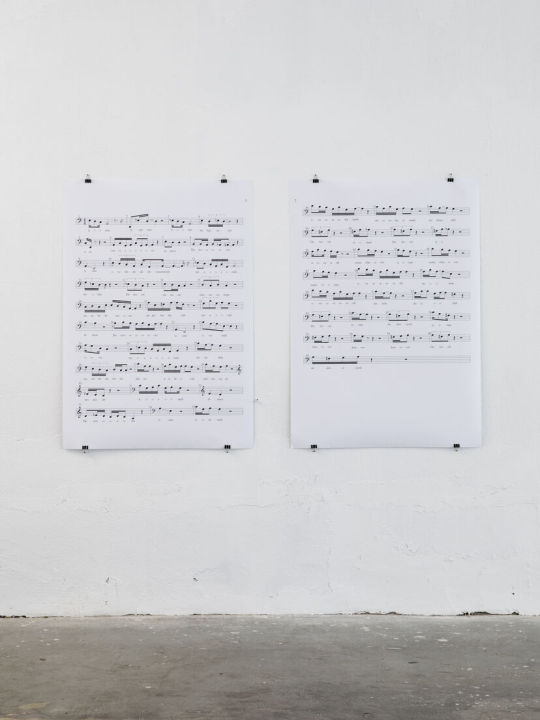
Steffani Jemison & Justin Hicks (Mikrokosmos)
Another time, this time, one time
24 Jun – 2 Jul 2022
CCA Berlin – Center for Contemporary Arts
Formed in 2016 as the collaborative platform of composer Justin Hicks and artist Steffani Jemison, Mikrokosmos mines the history of Black music. This ongoing project has manifested in many forms: workshop, study session, concert, listening session, book, prompt, score. The exhibition at CCA Berlin presents two related compositions inspired by Gil Scott-Heron’s ambitious songbook. Another time, this time, one time (Aaliyah, Barbara, Brandy, Chaka, David, Erykah, Gil, Lionel, Loleatta, Mariah, Marvin, Stevie) tracks a small group of melismatic* gestures across bodies and time; it is a search for the "mother run." Another time, this time, one time, the first Mikrokosmos LP, uses Gil Scott-Heron and Brian Jackson’s “We Almost Lost Detroit” (1977) as the raw material for R&B songwriting. Like a game in which new words are formed from existing letters, these live compositions and recompositions take the form of musical studies, samples, and improvisations. Jemison and Hicks reflect upon a wide range of subjects, including Scott-Heron’s biography, police violence in the United States, and the nuclear catastrophe that threatened the city of Detroit in 1966.
*Melisma (Greek: lit. 'song'; from melos, 'song, melody') is the singing of a single syllable of text while moving between several different notes in succession. Music sung in this style is referred to as melismatic. An informal term for melisma is a vocal run.
Justin Hicks is a multidisciplinary artist and performer who uses music and sound to investigate themes of presence, identity, and value. His work has been featured at Lincoln Center for the Performing Arts, Performance Space New York, The Public Theater, JACK, National Black Theatre, The Bushwick Starr, MoMA, Dixon Place, festival Steirischer Herbst (Graz, Austria), Western Front Society (Vancouver, BC), MASS MoCA, The Whitney Museum of American Art, Nottingham Contemporary (Nottingham, UK), The Albertinum - SKD (Dresden, DE), The Highline, and The John F. Kennedy Center for Performing Arts among others. Hicks has collaborated with notable visual artists, musicians, and theater-makers including Abigail DeVille, Charlotte Brathwaite, Kaneza Schaal, Meshell Ndegeocello, Cauleen Smith, Helga Davis, and Ayesha Jordan. He was the Drama Desk-nominated composer for Mlima’s Tale by Lynn Nottage (The Public Theater 2018 dir. Jo Bonney). His practice with artist Steffani Jemison, Mikrokosmos, has deployed commissioned performances and exhibitions internationally. Hicks was a member of Kara Walker’s 6-8 Months Space and holds a culinary diploma from ICE in New York City. He was born in Cincinnati, OH, and is based in the Bronx, NY.
Steffani Jemison was born in Berkeley, California and raised in Cincinnati, Ohio. Her work has been the subject of solo exhibitions and special projects at JOAN Los Angeles (2022), Contemporary Art Center Cincinnati (2021), the Everson Museum (2021), the Stedelijk Museum (2019), Nottingham Contemporary (2018), Jeu de Paume and CAPC Bordeaux (both 2017), MoMA, New York (2015), RISD Museum, Providence (2015), and LAXART, Los Angeles (2013) among others. Her work has been included in numerous group exhibitions, including the Guggenheim Museum (2021), the Whitney Biennial, New York (2019), the Museum of Contemporary Art Chicago (2019), and the Institute of Contemporary Art, Philadelphia (2017). It is in numerous public collections, including the Guggenheim Museum, the Hirshhorn Museum, the Studio Museum in Harlem, the Brooklyn Museum, the Whitney Museum, the Museum of Modern Art, the San Jose Museum of Art, the Albright-Knox Museum, the Stedelijk Museum, and others. Jemison currently lives and works in Brooklyn and is an Associate Professor at Rutgers University Mason Gross School of the Arts.
*Steffani Jemison & Justin Hicks' Another time, this time, one time is part of CCA Berlin's Stirring Up Trouble, a program unfolding until the end of June, and which aims to host, restage, and think alongside four distinct artistic positions that foreground acts of listening and their manifold potentialities. Through their practices, invited artists engage listening as a method of witnessing unseeable formations of violence (Lawrence Abu Hamdan); an invitation to inhabit tropical geographies otherwise (Kent Chan); an everyday practice of place-making and communitarian belonging (Black Obsidian Sound System); and a regenerative archival portal into shared inheritances and histories of struggle (Steffani Jemison and Justin Hicks). By tuning in to organized sounds, accidental leaks, and enforced silences, they conceive modes of aesthetic experience that challenge common perceptions of artmaking, and trace roadmaps to resonant imaginaries.
Stirring Up Trouble is generously supported by the foundation Between Bridges.
Co-conceived with Edwin Nasr.
1 note
·
View note
Photo










2019 Whitney Biennial - Set 1 of 2
Set 1 of 2 of photographs by Blair Prentice from the 2019 Whitney Biennial exhibition at the Whitney Museum of American Art.
With the 2019 Biennial, the Whitney Museum of American Art continues its commitment to understanding the current state of art in America today. The 79th installation is no exception, including the work of seventy-five artists and collectives working in the mediums of painting, sculpture, installation, film and video, photography, performance and sound.
In a nation experiencing the opposing forces of a booming economy and deep political polarization, curators Jane Panetta and Rujeko Hockley began to hear a chorus of voices seeking out ways to channel their confusion and anger into productive pursuits that might help to reconstitute a sense of community and equity.
Exhibition runs until September 22nd, 2019.
Photography by Blair Prentice of iheartmyart.com
Also see Set 2 of 2 of the photographs from the 2019 Whitney Biennial exhibition.
______
Whitney Museum of American Art: Website | Instagram
Blair Prentice: Website | Facebook
______
Discover more art on iheartmyart
More artwork from Whitney Museum of American Art on iheartmyart.
See more photography by Blair Prentice on iheartmyart.
Discover more photographs of exhibitions on iheartmyart.
Find us: Facebook | Twitter | Instagram | Mail List | Soundcloud
#Whitney Museum#whitney biennial#Whitney Biennial 2019#art#art exhibition#American art#Blair Prentice#photographer#NYC#new york city#iheartmyartgalleryvisits#iheartmyart feature#museum#painting#photography#sculpture#installation#film#video#performance art#sound art
112 notes
·
View notes
Text
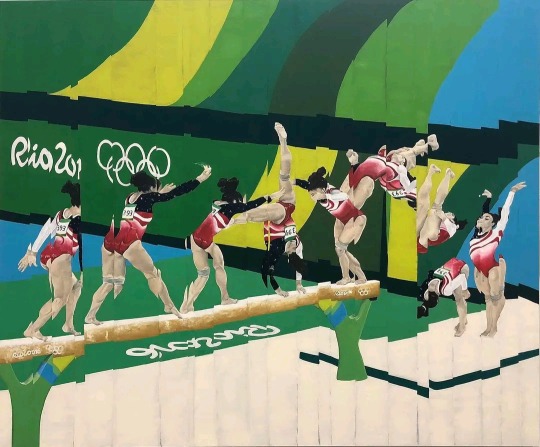
Jeanette Mundt (USA, b.1982)
Born Athlete American: Laurie Hernandez I, 2018
Oil and glitter on canvas, 50 × 60 in. (127 × 152.4 cm)
Jeanette Mundt is an American painter, best known for her works in the 2019 Whitney Biennial. Mundt was born in Princeton, New Jersey, but grew up in Zurich, Switzerland. via Wikipedia
#JeanetteMundt #painter #LaurieHernandez #womensart #womenpaintwomen #PalianShow
72 notes
·
View notes
Text
"Could I but find the words"–– Art vs. the Barbarians
A Romanian film, American art, and kids in cages . "Mariana had hoped that this alarming spectacle of national evil would shock the audience into an awakened conscience. Instead, the spectators seemed to enjoy the whole thing." #NoKidsInCages

The dictator and his holocaust in “I Do Not Care If We Go Down in History as Barbarians.”
If a nation’s sins go unconfessed, can it ever be free of them? Or will they continue to flare up, resistant to every cure? If measles can make a comeback, why not fascism, racism, anti-Semitism, or even Nazism? Radu Jude, a Romanian director, explores the persistence of evil in his demanding new film, “I Do…
View On WordPress
#"I do not care if we go down in history as barbarians"#NoKidsInCages#Art activism#Betye Saar "I&039;ll Bend but I Will Not Break"#Evil#Intolerance#Ioana Iacob#Langston Hughes#Nicholas Galanin "White Noise: American Prayer Rug"#Odessa massacre#Radu Jude#Where there is no vision#white supremacy#Whitney Biennial 2019#Winslow Homer "The Gulf Stream"
0 notes